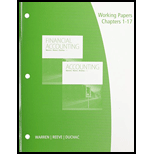
Working Papers, Chapters 1-17 for Warren/Reeve/Duchac's Accounting, 26th and Financial Accounting, 14th
26th Edition
ISBN: 9781305392373
Author: Carl Warren, Jim Reeve, Jonathan Duchac
Publisher: Cengage Learning
expand_more
expand_more
format_list_bulleted
Question
Chapter 4, Problem 4.6BPE
(a)
To determine
Ratio analysis
It is the financial analysis tool for measuring the profitability, liquidity, capability and overall performance of a company.
Following are the two measures of liquidity:
- 1.
Current ratio : Current ratio is used to determine the relationship between current assets and current liabilities. The ideal current ratio is 2:1. The following formula is used to calculate current ratio. - 2.
Working capital : Total current assets minus total current liabilities are the working capital of a company.
The working capital and current ratio for 2016 and 2015.
(b)
To determine
To Indicate: The change in current ratio form 2015 to 2016.
Expert Solution & Answer
Want to see the full answer?
Check out a sample textbook solution
Students have asked these similar questions
Solve this qn plz
I am searching for the accurate solution to this general accounting problem with the right approach.
Richard Gear Co. manufactures mountain bike tires. The tires sell for $75. The variable cost per tire is $40, and monthly fixed costs are $360,000. If the company is currently selling 18,000 tires monthly, what is the degree of operating leverage?
Chapter 4 Solutions
Working Papers, Chapters 1-17 for Warren/Reeve/Duchac's Accounting, 26th and Financial Accounting, 14th
Ch. 4 - Why do some accountants prepare an end-of-period...Ch. 4 - Describe the nature of the assets that compose the...Ch. 4 - Prob. 3DQCh. 4 - Prob. 4DQCh. 4 - Why are closing entries required at the end of an...Ch. 4 - What is the difference between adjusting entries...Ch. 4 - What is the purpose of the post-closing trial...Ch. 4 - Prob. 8DQCh. 4 - What is the natural business year?Ch. 4 - Prob. 10DQ
Ch. 4 - Prob. 4.1APECh. 4 - Flow of accounts into financial statements The...Ch. 4 - Statement of owner's equity Marcie Davies owns and...Ch. 4 - Statement of owners equity Blake Knudson owns and...Ch. 4 - Classified balance sheet The following accounts...Ch. 4 - Prob. 4.3BPECh. 4 - Closing entries After the accounts have been...Ch. 4 - Closing entries After the accounts have been...Ch. 4 - Accounting cycle From the following list of steps...Ch. 4 - Accounting cycle From the following list of steps...Ch. 4 - Prob. 4.6APECh. 4 - Prob. 4.6BPECh. 4 - Flow of accounts into financial statements The...Ch. 4 - Prob. 4.2EXCh. 4 - Financial statements from the end-of-period...Ch. 4 - Financial statements from the end-of-period...Ch. 4 - Income statement The following account balances...Ch. 4 - Prob. 4.6EXCh. 4 - Prob. 4.7EXCh. 4 - Statement of owner's equity Apex Systems Co....Ch. 4 - Statement of owners equity; net loss Selected...Ch. 4 - Prob. 4.10EXCh. 4 - Balance sheet classification At the balance sheet...Ch. 4 - Balance sheet Optimum Weight Loss Co. offers...Ch. 4 - Prob. 4.13EXCh. 4 - Prob. 4.14EXCh. 4 - Closing entries Prior to its closing, Income...Ch. 4 - Closing entries with net income After all revenue...Ch. 4 - Closing entries with net loss Mira Services Co....Ch. 4 - Prob. 4.18EXCh. 4 - Prob. 4.19EXCh. 4 - Steps in the accounting cycle Rearrange the...Ch. 4 - Prob. 4.21EXCh. 4 - Prob. 4.22EXCh. 4 - Completing an end-of-period spreadsheet List (a)...Ch. 4 - Prob. 4.24EXCh. 4 - Prob. 4.25EXCh. 4 - Appendix Completing an end-of-period spreadsheet...Ch. 4 - Appendix Adjustment data on an end-of-period...Ch. 4 - Appendix Completing an end-of-period spreadsheet...Ch. 4 - Prob. 4.1APRCh. 4 - Financial statements and closing entries Finders...Ch. 4 - T accounts, adjusting entries, financial...Ch. 4 - Ledger accounts, adjusting entries, financial...Ch. 4 - Complete accounting cycle For the past several...Ch. 4 - Financial statements and closing entries Last...Ch. 4 - Financial statements and closing entries The...Ch. 4 - T accounts, adjusting entries, financial...Ch. 4 - Ledger accounts, adjusting entries, financial...Ch. 4 - Complete accounting cycle For the past several...Ch. 4 - The unadjusted trial balance of PS Music as of...Ch. 4 - Kelly Pitney began her consulting business, Kelly...Ch. 4 - Prob. 4.1CPCh. 4 - Financial statements The following is an excerpt...Ch. 4 - Financial statements Assume that you recently...
Knowledge Booster
Similar questions
- Dylan Manufacturing had an estimated 90,000 direct labor hours, $360,000 manufacturing overhead, and 30,000 machine hours. The actual results were 91,200 direct labor hours, 32,500 machine hours, and $415,000 manufacturing overhead. Overhead is applied based on machine hours. Calculate the predetermined overhead rate. Need helparrow_forwardRivertown Media has reported a total asset turnover of 2.8 times and an ROA of 15% and ROE of 22%. What is the firm's net profit margin?arrow_forwardWhat is the return on equity ?arrow_forward
- Cypress Ltd.'s contribution margin is $250, after-tax income is $90, and the tax rate is 25%. What are the fixed costs? a. $65 b. $175 c. $130 d. None of the above HELParrow_forwardGeneral accounting question with helparrow_forwardDylan Manufacturing had an estimated 90,000 direct labor hours, $360,000 manufacturing overhead, and 30,000 machine hours. The actual results were 91,200 direct labor hours, 32,500 machine hours, and $415,000 manufacturing overhead. Overhead is applied based on machine hours. Calculate the predetermined overhead rate. Helparrow_forward
arrow_back_ios
SEE MORE QUESTIONS
arrow_forward_ios
Recommended textbooks for you
 Financial AccountingAccountingISBN:9781305088436Author:Carl Warren, Jim Reeve, Jonathan DuchacPublisher:Cengage Learning
Financial AccountingAccountingISBN:9781305088436Author:Carl Warren, Jim Reeve, Jonathan DuchacPublisher:Cengage Learning EBK CONTEMPORARY FINANCIAL MANAGEMENTFinanceISBN:9781337514835Author:MOYERPublisher:CENGAGE LEARNING - CONSIGNMENT
EBK CONTEMPORARY FINANCIAL MANAGEMENTFinanceISBN:9781337514835Author:MOYERPublisher:CENGAGE LEARNING - CONSIGNMENT

Financial Accounting
Accounting
ISBN:9781305088436
Author:Carl Warren, Jim Reeve, Jonathan Duchac
Publisher:Cengage Learning


EBK CONTEMPORARY FINANCIAL MANAGEMENT
Finance
ISBN:9781337514835
Author:MOYER
Publisher:CENGAGE LEARNING - CONSIGNMENT